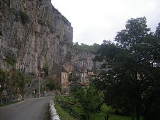
Cabrerets
Encyclopedia
Cabrerets is a commune
in the Lot department in south-western France
.
The village of Cabrerets derives its name from cabre, meaning goat
in the Occitan language.
and Célé
, at the foot of the Rochecourbe cliffs. The village also forms part of the pilgrimage route for those travelling to Santiago de Compostella and is the final stop before Cahors
.
. The Pech Merle
cave is home to prehistoric
cave painting
s, being one of the few sites in France which remain open to the general public.
In 1380, during the Hundred Years' War
, it fell into the hands of a force from Aquitaine
controlled by the English. It was liberated ten years later by Jean d'Hébrard, lord of Saint-Sulpice, who subsequently ordered its demolition.
Communes of France
The commune is the lowest level of administrative division in the French Republic. French communes are roughly equivalent to incorporated municipalities or villages in the United States or Gemeinden in Germany...
in the Lot department in south-western France
France
The French Republic , The French Republic , The French Republic , (commonly known as France , is a unitary semi-presidential republic in Western Europe with several overseas territories and islands located on other continents and in the Indian, Pacific, and Atlantic oceans. Metropolitan France...
.
The village of Cabrerets derives its name from cabre, meaning goat
Goat
The domestic goat is a subspecies of goat domesticated from the wild goat of southwest Asia and Eastern Europe. The goat is a member of the Bovidae family and is closely related to the sheep as both are in the goat-antelope subfamily Caprinae. There are over three hundred distinct breeds of...
in the Occitan language.
Geography
The village lies at the confluence of the rivers SagneSagne
Sagne may refer to:*La Sagne - Switzerland*Sagne, Mauritania...
and Célé
Célé
The Célé is a 104 km long river in the Cantal and Lot départements, south-western France, right tributary of the Lot River. Its source is near Calvinet. It flows generally west through the following départements and towns:* Cantal: Saint-Constant...
, at the foot of the Rochecourbe cliffs. The village also forms part of the pilgrimage route for those travelling to Santiago de Compostella and is the final stop before Cahors
Cahors
Cahors is the capital of the Lot department in south-western France.Its site is dramatic being contained on three sides within an udder shaped twist in the river Lot known as a 'presqu'île' or peninsula...
.
History
The overhanging cliffs that dominate the town are home to a ruined castle, built by the English and also known as the château du diable ("devil's castle"). The castle was first mentioned in a document dating from 1259, and was the medieval home of the lords of BarsacBarsac, Gironde
Barsac is a commune on the left bank of the Garonne river in the Gironde department in southwestern France.-Population:-Wine:The town gives its name to a wine making appellation, Barsac AOC, that produces sweet white wines....
. The Pech Merle
Pech Merle
Pech Merle is a cave which opens onto a hillside at Cabrerets in the Lot département of the Midi-Pyrénées region in France, about 35 minutes by road east of Cahors. It is the home of one of the few prehistoric cave painting sites in France which remain open to the general public...
cave is home to prehistoric
Pre-historic art
In the history of art, prehistoric art is all art produced in preliterate, prehistorical cultures beginning somewhere in very late geological history, and generally continuing until that culture either develops writing or other methods of record-keeping, or it makes significant contact with another...
cave painting
Cave painting
Cave paintings are paintings on cave walls and ceilings, and the term is used especially for those dating to prehistoric times. The earliest European cave paintings date to the Aurignacian, some 32,000 years ago. The purpose of the paleolithic cave paintings is not known...
s, being one of the few sites in France which remain open to the general public.
In 1380, during the Hundred Years' War
Hundred Years' War
The Hundred Years' War was a series of separate wars waged from 1337 to 1453 by the House of Valois and the House of Plantagenet, also known as the House of Anjou, for the French throne, which had become vacant upon the extinction of the senior Capetian line of French kings...
, it fell into the hands of a force from Aquitaine
Aquitaine
Aquitaine , archaic Guyenne/Guienne , is one of the 27 regions of France, in the south-western part of metropolitan France, along the Atlantic Ocean and the Pyrenees mountain range on the border with Spain. It comprises the 5 departments of Dordogne, :Lot et Garonne, :Pyrénées-Atlantiques, Landes...
controlled by the English. It was liberated ten years later by Jean d'Hébrard, lord of Saint-Sulpice, who subsequently ordered its demolition.

